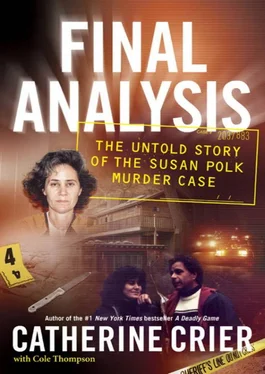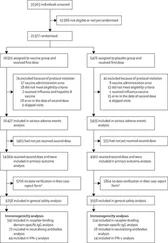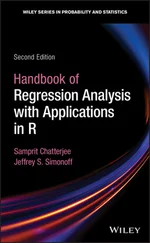On the evening of Wednesday, October 19, investigators served two search warrants on the home of Dyleski’s mother, Esther Fielding, “looking for any type of murder weapon that would cause blunt-force trauma or other injury.” Posters covered nearly every inch of wall space in Scott’s bedroom. Amid the clutter were drawings of symbols similar to the H-shape found carved into Vitale’s back. Three computers were seized by investigators, along with several knives, bedding, and other items. In a van behind the house, police found a duffel bag with Dyleski’s nametag. Inside, they found bloody clothes, shoes, and a ski mask that later tested positive for DNA from both Dyleski and Vitale.
The following morning, as friends and family were saying a final good-bye to Pamela at her funeral, her alleged killer was arrested and held in lieu of $1 million bail.
Six days after the killing, on October 21, the teen was brought before a Superior Court judge and charged with first degree murder as an adult. Handcuffs encircled his bony wrists, and strands of dark, wavy hair covered much of his angular face as he was led into the courtroom. Dyleski said nothing during the brief court appearance.
Details of his brief and troubled life would emerge in the days and weeks ahead. Interviews with schoolmates painted the teen as a loner who was mercilessly teased about the way he dressed by his classmates at Lafayette’s Acalanes High School. Friends said that Dyleski endured endless taunts for being “nerdy” while growing up in the small, rural town as a Boy Scout, a basketball player, and a good student in elementary school.
But something inside Scott seemed to die in 2001 when his eighteen-year-old half sister, Denika, was killed in a car crash. The once easygoing student suddenly began shaving parts of his head, wearing dark eyeliner and black nail polish and dying his brown hair jet black. He began dressing all in black accessorized by heavy silver jewelry and a long black trench coat like the one worn by rocker Marilyn Manson, the self-proclaimed “Anti-Christ Superstar” whose stage name merged that of Marilyn Monroe and Charles Manson.
One former classmate told the San Francisco Chronicle he believed Scott was trying to be noticed with his strange appearance and clothing. “I always thought he was trying to get attention,” Kevin McDonald said of Dyleski. “But he seemed like a nice guy, not someone who would ever do something like this.”
Dyleski had been reportedly studying hard for his GED, desperate to escape Acalanes High School and the teasing he endured. He was taking art classes at Mt. Diablo College in Pleasant Hill, the same junior college that Susan Polk had attended as a teenager, and had submitted some of his dark, imagery-driven art for grades. He was to celebrate his eighteenth birthday two weeks after the murder.
On January 12, 2006, Susan stood before Judge Laurel Brady and asked that she be allowed to fire Horowitz and Golde, her fourth attorneys, and represent herself in the murder trial. While the lawyers knew beforehand that she wanted them removed, Susan’s action both surprised and disappointed them, after having invested so much into the high-profile case.
Interestingly, her decision to replace them seemed to have little to do with Horowitz’s personal tragedy. As most lawyers who worked with Susan discovered, representing her was something of a roller-coaster ride. Just two weeks prior to her announcement, she had expressed concern for Horowitz’s well-being and seemed happy to have him as her attorney, but soon something soured her on his representation.
In the weeks leading up to the trial, Susan had made many calls to Horowitz’s office with countless requests. Horowitz assigned Valerie Harris to handle the multitude of Susan’s needs, but as time went on, that arrangement backfired. Susan began complaining about what she perceived as Dan’s lack of attention to her case and accused him of failing to file legal motions on her behalf. Once she felt neglected, it was not long before she notified Horowitz that his services were no longer needed.
“She has a right to an attorney of her choice,” Horowitz told reporters outside the courtroom. “But the judge may not let me out because we’re so close to trial. I feel sorry for her [Susan]. What can I say? Going through Pamela’s death was a horrible experience. It’s not deliberate. She’s not really trying to hurt me. She’s desperate and scared.”
During the ninety-minute hearing before Judge Brady, Susan claimed that Horowitz had all but ignored her case since his wife was murdered. Though Horowitz had already filed some forty motions with the court, Susan still wasn’t happy, claiming he had failed to file others for her. Despite the severity of the charges, Susan believed that she could represent herself in court. She asked that Harris, with whom Susan had formed a strong bond, be permitted to remain on her case as a consultant.
In addition to her complaints about Horowitz, Susan also filed a lengthy declaration on January 12 in which she outlined several grievances she had with the judge and police department. Among other things, Susan complained that Horowitz had failed to file her motion to disqualify Judge Brady and the entire Contra Costa County judiciary because they were all prejudiced against her. She also claimed that she had been subjected to discriminatory treatment by law enforcement since she had unsuccessfully moved to have Judge Brady removed from the case in August—including being “the only female prisoner” to be transported in shackles.
Susan also claimed that Dan Horowitz was a suspect in the murder of his wife. Later, she told reporters that she believed that Horowitz may have been involved in Pamela’s murder “based on statements he made to me.” She even offered to testify on behalf of the murder suspect, Scott Dyleski, at his upcoming pretrial hearing. Though Horowitz declined to respond publicly to Susan’s allegations, in part because a gag order had been issued, it was clear that he was infuriated by her remarks.
Not surprisingly, Judge Brady denied Susan’s motion to have the entire judiciary of Contra Costa County removed at a hearing on January 20, but she granted Susan’s request to dismiss Horowitz. The judge set a new trial date for February 27, giving Susan six weeks to prepare her defense.
“It is Susan’s story,” a visibly pale Dan Horowitz said while waiting in the hallway of the courthouse after the hearing. “She lived it and she wants to tell it. She has the absolute right to present her own defense.”
Ivan Golde chose to phrase it a bit differently: “It’s a very sad day,” he said.
Chapter Twenty-three
GOING IT ALONE
On February 27, 2006, three hundred prospective jurors arrived at the Contra Costa County Courthouse in Martinez to begin jury selection in the murder trial of Susan Polk.
Surprisingly, Polk’s original prosecutor, Tom O’Connor, had announced his resignation from the D.A.’s office just one week earlier to take a job in the private sector. A senior prosecutor, Paul Sequeira, was immediately assigned to take his place. Though new to the case, Sequeira told the media that he was rapidly getting up to speed and regarded the case as fairly straightforward.
With no lawyer by her side, Susan was relying on Valerie Harris and had a jury consultant to help with the selection process. Prospective jurors arriving at the courthouse were first directed to an assembly room where Judge Brady informed them about Susan’s decision to represent herself. She asked jurors if they could fairly adjudicate the case under that scenario. Those who expressed doubts were immediately excused. The others were directed to the courtroom where Susan and Paul Sequeria would conduct their questioning.
Читать дальше











